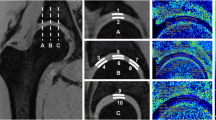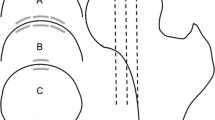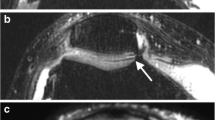Abstract
Objectives
We aimed to evaluate the feasibility of triple-echo steady state (TESS) T2 mapping as an alternative to conventional multi-echo-spin-echo (CPMG) T2 mapping for the quantitative assessment of hip joint cartilage at 7 T.
Materials and methods
A total of eight healthy volunteers and three patients were included. Reproducibility of both techniques was evaluated in five volunteers in five scans each. T2 relaxation times were measured by manually drawing regions of interest in multiple regions of the hip joint. Data from both methods were compared using Pearson correlation coefficient, intra-class correlation coefficient, and coefficient of repeatability. The overall image quality and presence of artifacts was assessed.
Results
Cartilage transplant and surrounding fluid were well depicted by both methods. Compared to CPMG, TESS provided systematically reduced T2 values (43.3 ± 7.3 vs. 19.2 ± 5.5 ms for acetabular cartilage, and 41.4 ± 5.6 vs. 21.7 ± 5.2 ms for femoral cartilage), in line with previously reported values. No correlation between both methods was found. TESS yielded a slightly better reproducibility than CPMG, while CPMG showed pronounced sensitivity to B1 inhomogeneities.
Conclusion
TESS seems to be an attractive alternative to CPMG for improvements in quantitative hip joint imaging at 7 T, allowing shortening of the total acquisition time paired with insensitivity to B1, while rendering comparable image quality with good repeatability.







Similar content being viewed by others
References
Krug R, Stehling C, Kelley DA, Majumdar S, Link TM (2009) Imaging of the musculoskeletal system in vivo using ultra-high field magnetic resonance at 7 T. Invest Radiol 44(9):613–618
Welsch GH, Apprich S, Zbyn S, Mamisch TC, Mlynarik V, Scheffler K, Bieri O, Trattnig S (2011) Biochemical (T2, T2* and magnetisation transfer ratio) MRI of knee cartilage: feasibility at ultra-high field (7T) compared with high field (3T) strength. Eur Radiol 21(6):1136–1143
Ellermann J, Goerke U, Morgan P, Ugurbil K, Tian J, Schmitter S, Vaughan T, Van De Moortele PF (2012) Simultaneous bilateral hip joint imaging at 7 Tesla using fast transmit B(1) shimming methods and multichannel transmission—a feasibility study. NMR Biomed 25(10):1202–1208
Chang G, Deniz CM, Honig S, Egol K, Regatte RR, Zhu Y, Sodickson DK, Brown R (2014) MRI of the hip at 7T: feasibility of bone microarchitecture, high-resolution cartilage, and clinical imaging. J Magn Reson Imaging 39(6):1384–1393
Theysohn JM, Kraff O, Orzada S, Theysohn N, Classen T, Landgraeber S, Ladd ME, Lauenstein TC (2013) Bilateral hip imaging at 7 Tesla using a multi-channel transmit technology: initial results presenting anatomical detail in healthy volunteers and pathological changes in patients with avascular necrosis of the femoral head. Skeletal Radiol 42(11):1555–1563
Kijowski R (2010) Clinical cartilage imaging of the knee and hip joints. AJR Am J Roentgenol 195(3):618–628
Theysohn JM, Kraff O, Theysohn N, Orzada S, Landgraeber S, Ladd ME, Lauenstein TC (2014) Hip imaging of avascular necrosis at 7 Tesla compared with 3 Tesla. Skeletal Radiol 43(5):623–632
Lazik A, Theysohn JM, Geis C, Johst S, Ladd ME, Quick HH, Kraff O (2015) 7 Tesla quantitative hip MRI: T1, T2 and T2* mapping of hip cartilage in healthy volunteers. Eur Radiol 26(5):1245–1253. doi:10.1007/s00330-015-3964-0
Meiboom S, Gill D (1958) Modified spin-echo method for measuring nuclear relaxation times. Rev Sci Instrum 29(8):688–691
Lebel RM, Wilman AH (2010) Transverse Relaxometry with Stimulated Echo Compensation. Magn Reson Med 64(4):1005–1014
Liney GP, Knowles AJ, Manton DJ, Turnbull LW, Blackband SJ, Horsman A (1996) Comparison of conventional single echo and multi-echo sequences with a fast spin echo sequence for quantitative T2 mapping: application to the prostate. J Magn Reson Imaging 6(4):603–607
Heule R, Ganter C, Bieri O (2014) Triple echo steady-state (TESS) relaxometry. Magn Reson Med 71(1):230–237
Heule R, Bar P, Mirkes C, Scheffler K, Trattnig S, Bieri O (2014) Triple-echo steady-state T2 relaxometry of the human brain at high to ultra-high fields. NMR Biomed 27(9):1037–1045
Riegler G, Drlicek G, Kronnerwetter C, Heule R, Bieri O, Hager B, Bär P (2015) Trattnig, Siegfried Triple-echo steady-state T2 mapping and high resolution axonal bundle assessment of the median nerve in healthy volunteers and patients with carpal tunnel syndrome at 7 Tesla. Proceedings 23rd Scientific Meeting. International Society for Magnetic Resonance in Medicine, Toronto, p 4226
Juras V, Bohndorf K, Heule R, Kronnerwetter C, Szomolanyi P, Hager B, Bieri O, Zbyn S, Trattnig S (2015) A comparison of multi-echo spin-echo and triple-echo steady-state T2 mapping for in vivo evaluation of articular cartilage. Eur Radiol. doi:10.1007/s00330-015-3979-6
Santini F, Patil S, Scheffler K (2011) IceLuva: a scripting framework for mr image reconstruction based on free software. Concepts Magn Reson Part B Magn Reson Eng 39B(1):1–10
Lazik A, Kraff O, Koersmeier K, Johst S, Geis C, Quick HH, Theysohn JM (2015) A Comprehensive 7 Tesla Hip Cartilage Protocol Including Morphological and Quantitative MRI Techniques and Its Application in Patients after Acetabular Autologous Chondrocyte Transplantation. In: Proceedings Scientific Assembly and Annual Meeting, Radiological Society of North America Chicago, IL, pp SSC07-06
Bland JM, Altman DG (1986) Statistical methods for assessing agreement between two methods of clinical measurement. Lancet 1(8476):307–310
Hagiwara S, Nakamura J, Watanabe A, Kishida S, Ohtori S, Omae T, Miyamoto S, Orita S, Takahashi K (2015) Corticosteroids and low bone mineral density affect hip cartilage in systemic lupus erythematosus patients: quantitative T2 mapping. J Magn Reson Imaging 42(6):1524–1531. doi:10.1002/jmri.24953
Kurkijarvi JE, Nissi MJ, Kiviranta I, Jurvelin JS, Nieminen MT (2004) Delayed gadolinium-enhanced MRI of cartilage (dGEMRIC) and T2 characteristics of human knee articular cartilage: topographical variation and relationships to mechanical properties. Magn Reson Med 52(1):41–46
Hannila I, Lammentausta E, Tervonen O, Nieminen MT (2015) The repeatability of T2 relaxation time measurement of human knee articular cartilage. Magn Reson Mater Phy 28(6):547–553
Voogt IJ, Klomp DWJ, Hoogduin H, Luttje MP, Luijten PR, van den Berg CAT, Raaijmakers AJE (2015) Combined 8-channel transceiver fractionated dipole antenna array with a 16-channel loop coil receive array for body imaging at 7 Tesla. Proceedings 23rd Scientific Meeting. International Society for Magnetic Resonance in Medicine, Toronto, p 631
Lattanzi R, Petchprapa C, Glaser C, Dunham K, Mikheev AV, Krigel A, Mamisch TC, Kim YJ, Rusinek H, Recht M (2012) A new method to analyze dGEMRIC measurements in femoroacetabular impingement: preliminary validation against arthroscopic findings. Osteoarthr Cartil 20(10):1127–1133
Trattnig S, Ohel K, Mlynarik V, Juras V, Zbyn S, Korner A (2015) Morphological and compositional monitoring of a new cell-free cartilage repair hydrogel technology - GelrinC by MR using semi-quantitative MOCART scoring and quantitative T2 index and new zonal T2 index calculation. Osteoarthr Cartil 23(12):2224–2232
Neumann D, Blaimer M, Jakob PM, Breuer FA (2014) Simple recipe for accurate T(2) quantification with multi spin-echo acquisitions. Magn Reson Mater Phy 27(6):567–577
Acknowledgments
This work was supported by a research grant (IFORES) of the University Hospital Essen, Germany.
Author information
Authors and Affiliations
Corresponding author
Ethics declarations
Conflict of interest
The authors declare that they have no conflict of interest.
Ethical standard
All procedures performed in studies involving human participants were in accordance with the ethical standards of the institutional and/or national research committee and with the 1964 Helsinki declaration and its later amendments or comparable ethical standards.
Informed consent
Informed consent was obtained from all individual participants included in the study.
Rights and permissions
About this article
Cite this article
Kraff, O., Lazik-Palm, A., Heule, R. et al. 7 Tesla quantitative hip MRI: a comparison between TESS and CPMG for T2 mapping. Magn Reson Mater Phy 29, 503–512 (2016). https://doi.org/10.1007/s10334-016-0557-0
Received:
Revised:
Accepted:
Published:
Issue Date:
DOI: https://doi.org/10.1007/s10334-016-0557-0




